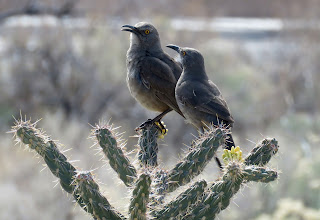It has long been "common knowledge" that only male birds sing. However, more and more research now shows that this is more like a common misapprehension, perhaps based on implict bias and the fact that most research has focused on male birds. More recent research is showing many male-female pairs in North America that do call-and-response singing. And this is even more common in the Southern Hemisphere.
So, an intriguing question. And it reminded me of an intriguing situation that I witnessed last March, not in my neighborhood, but in the near-by Sandia Foothills. There were a pair of Curve-Billed Thrashers. One was perched on top of a cholla, singing.
In the next moment. A second Thrasher joined the first on the Cholla. With the expectation that the singer would be the male. But scroll through these photos that I shot in quick succession and observe the body language as the 2nd Thrasher engages in a sort of begging display.


This courtship behavior also appears to be behavior we would normally associate with a male bird, who usually appears to be the one trying to court the female's favor, who has the power to choose "yea" or "nay." In the next moment, the "courting" bird of the pair moves off, as if she or he has been given the message to back off, as least for the moment.
Observing the lives of species other than our own often brings up more questions than answers. What exactly was happening here? Is this another example of birds not behaving according to the biases we expect? However perplexing. it was to me, it certainly wasn't to them.
Meanwhile, about a 1/4 mile away, another pair were working together on building a nest. They took turns bringing material to the nest. One (I couldn't tell if they took turns on this) would get into the nest and scrabble around to shape it. Behavior that was easier to understand, but no less fascinating!
All this was happening right at the time that stay-at-home orders were called for New Mexico due to the Covid pandemic. I decided to turn my attention to finding Curve-Billed Thrasher nests in my neighborhood. But that is for my next entry.










No comments:
Post a Comment